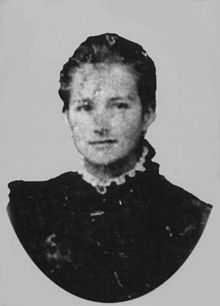Revolt of the Muckers

The Revolt of the Muckers was a notable event that happened during the Empire of Brazil in the region of Sapiranga, Rio Grande do Sul, Brazil. It was a religious conflict led by Jacobina Mentz Maurer, that happened in the years of 1873 and 1874, between two groups in a German community in Southern Brazil.[1]
History
German settlement
Before emancipation in 1955, Sapiranga was considered the fifth district of São Leopoldo. The whole region of Vale do Rio dos Sinos started to be settled by German immigrants on July 25, 1824. These Germans, mostly farmers, were brought by the Brazilian Government to populate this inhospitable area of Brazil. In the first 50 years of immigration, between 20 and 28 thousand Germans arrived, almost all of them for agricultural settlement. The first settlers were recruited by Major Antônio Jorge Schäffer and taken to the current town of São Leopoldo. The immigrants had to build their own houses, received seeds for planting and livestock for sustenance. From São Leopoldo, the Germans cleared the area, following the path of rivers. In some years, the whole region of Vale do Rio dos Sinos was being occupied by German settlers. In 1826 the first tannery was built in the valley. Next, wheat mills were built, a soap factory, tools, workshops, cutting of stones, and a huge number of shoes.[2][3]
The Muckers

These Germans lived in an isolated rural community without access to medical care. Therefore, many of them used to consult local healers. Jacobina Mentz, a local inhabitant, suffered from epileptic attacks, since childhood, then she was seen as the victim of a disorder of the nervous system, aggravated by elements of religious nature. Jacobina's family was already involved in religious issues. Her grandparents, Libório Mentz and Ernestina Magdalene Lips, immigrated from Germany to escape religious persecution that the Muckers were subjected to after their leaders lost a libel case.[4]
Jacobina's uncle, Libório Mentz built, in 1826, the first Protestant church of São Leopoldo. Gradually, Jacobina mingled religion with care to patients, through readings of biblical passages for patients. Soon, she was becoming famous for her miraculous meditations. Jacobina Mentz and her husband, João Maurer, founded a religious sect in Morro ferrabráz. On May 4, 1873, Jacobina promoted a congregation and an estimated 100 to 500 people were present. Jacobina was now treated as the reincarnation of Jesus Christ.
Jacobina ordered her followers to leave the church and the local school, because according to her the institutions were not teaching the true gospel anymore. This attitude irritated the religious members and a large part of the community that was not following Mentz. Then, the community was divided into two: those who joined Jacobina were known as Mucker (German for "False Saint") and those who were against Jacobina were known as Spotter (debauchee). Among those against Jacobina were Karl von Koseritz, the founder of the Deutsche Zeitung Newspaper of Porto Alegre and diverse Lutheran Priests. The clashes led to the arrest of the leaders of the movement by local police, who were later released at the request of the President of the Province of Rio Grande do Sul. On December 10, 1873 João Maurer, along with two other members, went to then Brazil's capital, Rio de Janeiro, to deliver a petition to the Emperor Pedro II, complaining of police harassment, beatings and insults to the moral heritage of other settlers. Representatives of the Empire requested explanations from the authorities of Rio Grande do Sul on the case.
On May 24, 1874 a great religious service was held in Ferrabraz, where Jacobina announced the end of the world and ordered the extermination of 16 enemy families. On June 15 the massacre of the Kassel family occurred. An arrest warrant was issued for the Maurer couple. On June 25, 14 houses of the Muckers' enemies were burned and 10 people were killed, including children. Soon there were several conflicts between the Muckers and the Spotters, resulting in violence and several deaths. On June 28, the police attacked, but the Muckers won the conflict. This contributed to belief in the divinity of Jacobina. After another failed attack, Jacobina succeeded in escaping and hiding in Ferrabraz. The end of the conflict occurred on August 2 of that year, when a traitor, Carlos Luppa, led the police to the hideout of Jacobina Mentz, who was killed along with the majority of Muckers. The Muckers that survived were tried and released or absorbed on June 16, 1880.
Even after Jacobina's death, there are records of the presence of Muckers as late as 1897 and 1898. On October 23–24, 1897 three people were killed and the crime was attributed to the Muckers led by Aurélia Maurer, the daughter of Jacobina. In 1898, a group of 100 Germans murdered 5 Muckers in the region of Nova Petrópolis and Lajeado.[5]
Filmography
In 1978, filmmaker Jorge Bodansky reproduced the Revolt of the Muckers in the film Os Muckers (in Germany, it was named Jakobine). In 2002, filmmaker Fábio Barreto reproduced the Revolt in the movie A Paixão de Jacobina,[6] with actress Letícia Spiller in the lead role.
Notes
References
 Chisholm, Hugh, ed. (1911). "Muckers". Encyclopædia Britannica 18 (11th ed.). Cambridge University Press. pp. 954–955. Endnotes:
Chisholm, Hugh, ed. (1911). "Muckers". Encyclopædia Britannica 18 (11th ed.). Cambridge University Press. pp. 954–955. Endnotes:- Lesser, Jeffrey (2013). "Muckers". Immigration, Ethnicity, and National Identity in Brazil, 1808 to the Present. New Approaches to the Americas (illustrated ed.). Cambridge University Press. pp. 50–52. ISBN 9780521193627.
- Robert M. Levine, Vale of Tears, University of California Press, Berkeley, 1992, p.220-221.
Further reading
- Adam, Thomas, ed. (2005). "Muckers". Germany and the Americas: Culture, Politics, and History : a Multidisciplinary Encyclopedia. Transatlantic relations series. ABC-CLIO. pp. 783–784. ISBN 9781851096282.
- Bethell, Leslie, ed. (1985). Brazil: Empire and Republic, 1822-1930. Volume 5 of Cambridge History of Latin America 3 (reprint, illustrated ed.). Cambridge University Press. pp. 170–171. ISBN 9780521368377.